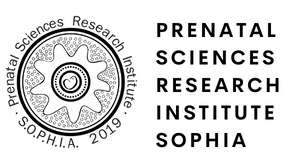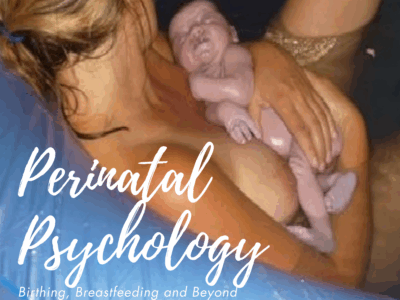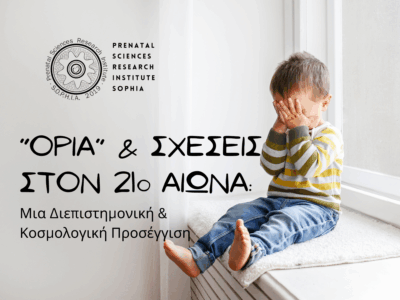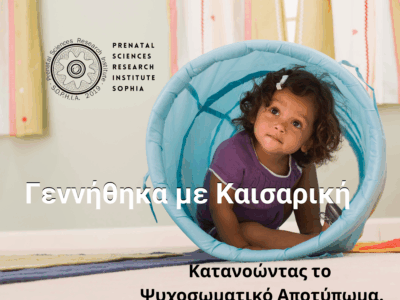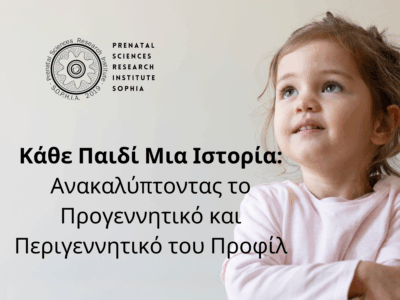Starts January 2026 | online teaching/ hybrid| Continuing Professional Training| in English and in Greek| 10 payments of 300 euros each
Aims and Goals of the Module
Bonding and Attachment. On Planetary Education
This module explores the fundamental importance of early relational experiences—beginning before conception and continuing through gestation, birth and early infancy—in shaping human development, relational capacities, and lifelong wellbeing.
Drawing from prenatal sciences, the module aims to:
-
Clarify the Distinction Between Bonding and Attachment
Students will examine the conceptual and experiential differences between bonding—a term that comes from Chemistry—and attachment—the developing relationship from the infant’s side. The temporal, emotional, and behavioral processes involved in both will be explored, emphasizing that attachment is not instant but develops over space/time. -
Highlight the Significance of the Prenatal Period
The module emphasizes the psychological and relational importance of the antenatal period as a time of transformation, identity shift, and emotional adjustment. Students will learn why this period matters—not just physiologically, but as a formative phase of communication and connection between the unborn baby and their environment. -
Introduce the Dynamics of Prenatal Communication
Students will study the bidirectional, often subtle forms of communication between the unborn baby and the maternal (and paternal, familial, societal, and even cosmic) environment. These dynamics will be viewed as the foundations for the baby’s sense of safety, self, and relational capacities, all in service of the child’s entelechy within cosmic entelechy. -
Explore the Concept and Practice of Bonding Analysis
The work of György Hidas and his approach to Bonding Analysis will be presented, providing insight into the therapeutic and developmental benefits of conscious prenatal dialogue and emotional preparation. Key principles and applications of this method will be discussed. -
Understand the Impact of Perinatal Bonding on Lifelong Relationships
The module will explore how experiences during pregnancy, birth, and the early postnatal period contribute to relational templates that shape future relationships. Students will consider how these patterns emerge in both personal and professional contexts. -
Study Attachment Theory and Observation Techniques
John Bowlby’s Attachment Theory will be introduced, along with practical tools for observing attachment styles in infants and young children. Students will learn how to assess attachment patterns and how to provide professional support to foster secure and healthy attachment relationships. -
Integrate Emerging Insights through Planetary Education
As the field evolves, the module culminates in an introduction to Planetary Education as developed by the author. Students will be invited to consider how bonding and attachment, grounded in early human experience, extend into a wider planetary consciousness that includes care for humanity and the Earth.
Competency-Based Expected Learning Outcomes
Continuing Professional Development (CPD)
By the end of this module, participants will be able to:
-
Differentiate between bonding and attachment processes, recognizing their distinct developmental timelines, psychological functions, and implications for early relational health.
-
Analyze prenatal relational dynamics with professional sensitivity, including the emotional and physiological exchanges between the unborn baby and the mother, father, family, and wider social, historical, cultural environment.
-
Interpret multidirectional communication in the prenatal period as a relational field, enabling practitioners to engage with unborn babies and parents as co-creating participants in early relationship-building.
-
Apply core principles of Bonding Analysis (based on the work of György Hidas) to professional scenarios, recognizing how prebirth dialogues can be facilitated, supported, and ethically integrated into prenatal care.
-
Assess the impact of perinatal experiences on lifelong development, incorporating evidence-based insights to understand how birth processes and early caregiving shape later emotional, social, and relational patterns.
-
Observe and interpret attachment behaviors in infants and toddlers, utilizing theoretical frameworks (e.g., Bowlby, Ainsworth) to inform professional interventions and support families in fostering secure attachments.
-
Gain tools for professional development to better support families and prenates.
-
Identify patterns in the ancestral and historical field, gaining competence in recognizing transgenerational influences and inherited emotional dynamics that may surface during the bonding and attachment process.
-
Demonstrate ecological awareness and planetary consciousness, acknowledging the interconnection of all life and embedding early relational care within a broader ethic of sustainability and planetary responsibility.
-
Articulate the relevance of cosmic and universal patterns to early human development, fostering a sense of purpose, coherence, and meaning within the caregiving relationship and professional practice.
-
Recognize the planetary and ecological dimensions of bonding.
-
Appreciate the interconnectedness of all life forms through shared principles of bonding.
-
Engage in reflective, ethical, and empathic professional practice, increasing attunement to the subtle needs of the baby and parents, and demonstrating improved capacity for supportive, non-invasive, and transformative interaction.
Why This Module Is Important for Professionals
Professionals working with individuals of all ages, babies, parents, and families—whether in health, education, psychology, social work, or related fields—require updated, multidimensional understandings of human development. Many existing training programs on bonding and attachment rely almost exclusively on early 20th-century frameworks, focusing narrowly on postnatal caregiving and early childhood interactions. These approaches, while foundational, are no longer sufficient in addressing the complexity and scope of contemporary needs and knowledge.
This module fills that gap by:
-
Expanding the understanding of bonding far beyond the postnatal period, tracing it back not only to conception and gestation but to the very origins of life—to the beginning of the cosmos, where connection, responsiveness, and relationality are foundational organizing principles. Bonding is not a human invention; it is a universal pattern visible in all living systems.
-
Bringing bonding and attachment into the 21st century, combining classical theories with newer insights from prenatal and perinatal psychology, epigenetics, neuroscience, consciousness studies, and planetary science.
-
Introducing the unborn baby as an aware, communicative participant in their relational field, whose experiences during gestation are central to the development of lifelong patterns of connection, trust, and meaning.
-
Incorporating the work of contemporary visionaries in different disciplines, it gives professionals practical and respectful tools to support early relationship formation.
-
Recognizing transgenerational patterns and ancestral fields that influence early relational dynamics, helping professionals work more effectively with inherited emotional imprints and intergenerational trauma.
-
Responding to a rapidly changing world, in which care practices must evolve to include relational, ecological, and ethical literacy. The development of secure relationships cannot be separated from the development of a planet-friendly, life-honoring worldview.
-
Supporting professionals in cultivating planetary consciousness, where every caregiving act is situated within a larger ecosystem of relationships—familial, societal, and cosmic.
In short, this module helps professionals reclaim bonding as a fundamental, cosmic process—one that underlies not only personal relationships but also ecological balance and the continuity of life itself. It equips learners to move beyond protocol into presence, beyond clinical frameworks into cosmological understanding, and beyond fragmented care into whole-system, life-affirming practice.
Who Is This Course For?
This module is designed for professionals and advanced learners across diverse fields who seek a deeper, updated, and more interconnected understanding of bonding and attachment, starting from preconception and extending into the cosmic context of life.
It is particularly relevant for:
-
Psychologists, psychiatrists, psychotherapists, and counselors – to understand how early relational patterns, including transgenerational influences, shape emotional development and mental health from the very beginning of life.
-
Medical and mental health professionals – to integrate beyond the somatic, psychological, and epigenetic dimensions of early life into their clinical understanding and patient care.
- Midwives, doulas, and birth professionals – to deepen their sensitivity to prenatal bonding and better support families in early relational formation, including during pregnancy, birth, and the postpartum period.
-
Educators and early childhood practitioners – to recognize how prenatal and perinatal experiences influence learning, regulation, and relational dynamics in children.
-
Social workers and family support workers – to support families in strengthening early bonds and addressing systemic, cultural, and ancestral challenges that may affect attachment.
-
Professionals in adoption, foster care, and trauma recovery – to bring insight into the impact of interrupted or non-optimal bonding experiences and develop informed, reparative practices.
-
Researchers and students in prenatal sciences, human development, and consciousness studies – to explore the integrative view of bonding as a universal pattern, rooted in both biological and cosmological dimensions.
-
Spiritual care providers and interfaith companions – to hold space for the sacred relational unfolding from womb to world, while bridging psychological insight and planetary awareness.
-
Policymakers and advocates for early life – to shape policies that honor the earliest phases of human development as essential to public health, equity, and sustainable societal growth.
This module serves as continuing professional development (CPD) for those already in practice, and as foundational preparation for those entering the field with a desire to work in more attuned, life-affirming ways.
By integrating classical theory, cutting-edge science, ancestral awareness, and planetary ethics, this course equips participants to meet the needs of our time—relationally, consciously, and responsibly.
“Bonding is not merely a moment between parent and child—it is a cosmic pattern, a timeless dialogue that begins before conception and extends into every relationship we form, with each other and with the Earth. To support bonding is to support life itself.”
Course Features
- Lectures 10
- Quiz 0
- Duration 240 hours
- Skill level All levels
- Language English
- Students 0
- Certificate Yes
- Assessments Self
- 3 Sections
- 10 Lessons
- 240 Hours
- Part 1: On BondingBonding is a foundational principle that precedes even life itself. Long before birth, bonding exists as a physical force, a molecular necessity, and a relational imperative. This part of the course explores bonding as a universal organizing process—from atomic structures and ecological systems to prenatal development and human culture. Bonding is what holds things together: cells, people, societies, and even galaxies. It is the blueprint of life’s cohesion, continuity, and interdependence. We will explore how bonding arises, what conditions support or distort it, and how early prenatal bonding shapes not only a person’s future attachments but also collective human behavior. From ancient myths to modern neuroscience, from womb to cosmos, this part lays the groundwork for a planetary understanding of the relational field.10
- 1.1The Architecture of Bonding – From Atoms to Lifeforms5 Hours
- 1.2Bonding and Symbiosis – Why do we Depend on Mutuality? The Logic of Interdependence5 Hours
- 1.3A History of Holding – Bonding Across Time and Culture: Historical, Cultural, and Ancestral Perspectives5 Hours
- 1.4From Cosmic Bonding to the Neurobiology and Biochemistry of Human Bonding5 Hours
- 1.5Disruptions in Bonding – Patterns, Mirrors, and Interpretation: When Experience Alters Connection5 Hours
- 1.6Prenatal Bonding and Epigenetics – Consequences and Potentials5 Hours
- 1.7The Long Arc – Postnatal Effects of Early Bonding5 Hours
- 1.8Bonding in Art, Literature, Social Thought and Philosophy5 Hours
- 1.9The Ecology of Bonding – Nature’s Web of Relationships5 Hours
- 1.10Integrative Dialogue and Reflection. Bonding as Professional Practice – Tools and Applications5 Hours
- Part 2: On Attachment0
- Part 3: On Prenatal Planetary Education0
